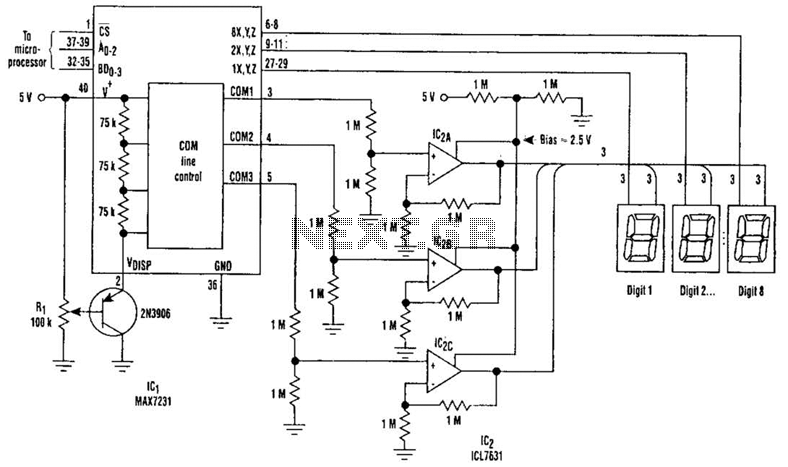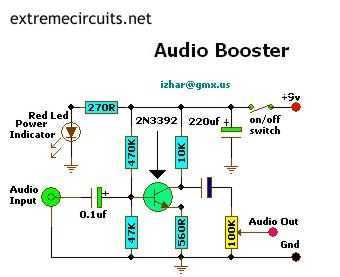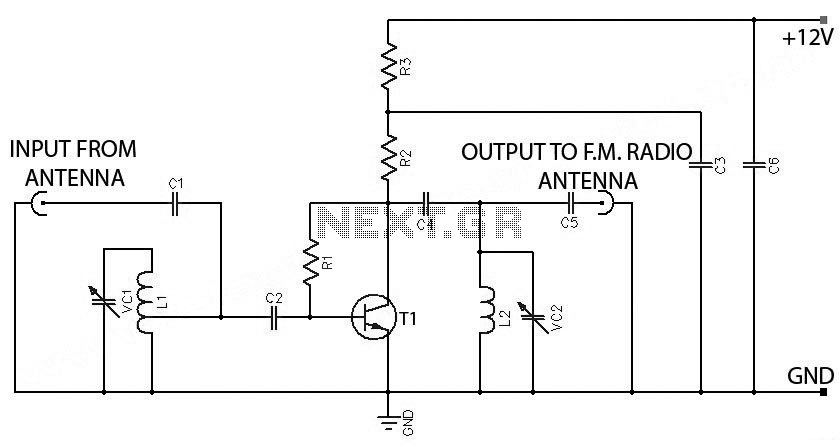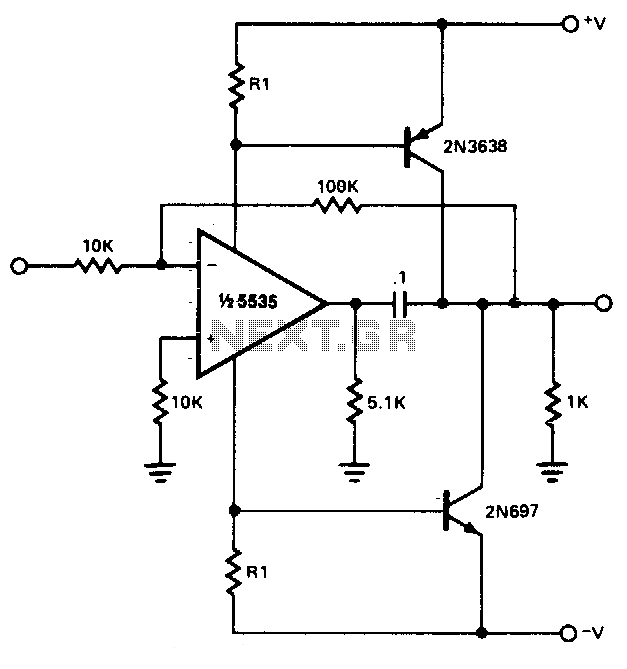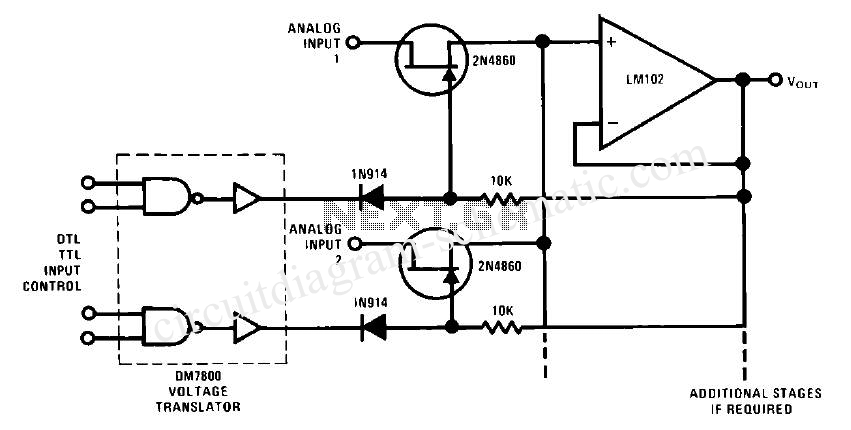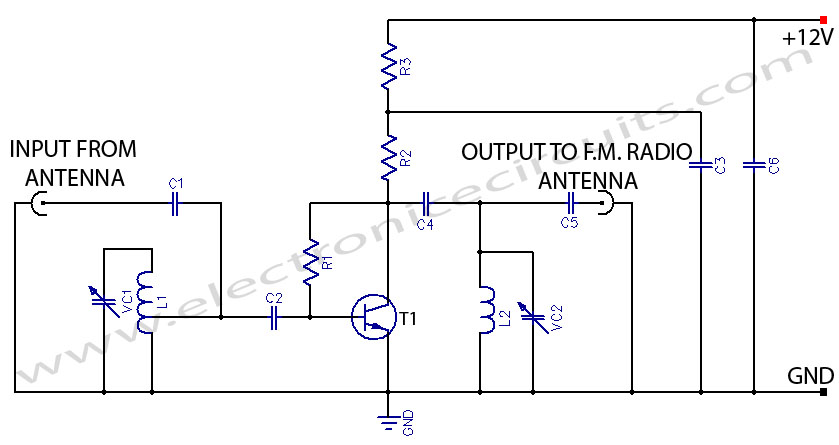
Multi-Purpose Booster and Buffer
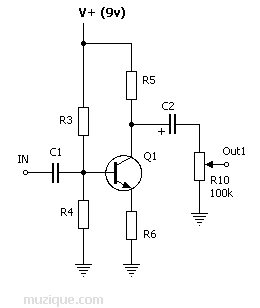
This document provides the complete schematic for the circuit found on the AMZ Multi-Purpose PC Board. The example circuits do not utilize every component placed on the board; additional parts have been included to enhance flexibility and options. The primary objective is to create a single PC board that can support multiple projects, such as boosters, buffers, and more. If a component is not represented in the schematic or the parts list for a specific circuit, it is not necessary for that project and can be left unpopulated on the PCB. The circular symbol located above the "Gr" designation indicates the transistor position (Q1), which is sufficiently sized to accommodate a TO-5 package. The small tab on the bottom left edge denotes the emitter lead. When using a TO-92 bipolar transistor (E-B-C), it should be oriented with the flat side facing right, positioning the emitter at the bottom and the collector at the top. The base lead may need to be bent slightly to fit into the middle hole. It is important to note that a BC108-style transistor follows a C-B-E configuration and should have the flat side facing left. Always consult the transistor datasheet for the correct pin designations. Additionally, there are a few notable features on the PCB. A small circular pad is located directly above the printed R3 designation; this pad is utilized for a limited number of circuits and is ignored otherwise. The R5 position contains three pads situated between the resistor pads, intended for an optional trimpot that may serve as the R5 resistor in certain circuit variations. If the trimpot is not specified, the pads should be disregarded, and the resistor should be soldered across the pads above and below the R5 box. Furthermore, polarity indicators have been added for capacitors C2, C3, and C4, which are not marked on the PCB. The positive side of electrolytic capacitors must be oriented toward the plus signs as required. These markings are accurate for NPN transistors and n-channel FET or MOSFET circuits. The circuit illustrated is a basic bipolar transistor booster, akin to the classic LPB-1 design, characterized by its simplicity and high gain. The R10 potentiometer is mounted externally to the PCB.
The AMZ Multi-Purpose PC Board schematic is designed for versatility, allowing users to create a variety of electronic projects with minimal modification. The inclusion of extra components provides an opportunity for customization, enabling users to adapt the board for specific applications, including signal amplification and buffering.
The transistor position (Q1) is critical in the circuit design, as it determines the gain characteristics and overall performance. The choice of using a TO-92 or BC108 transistor depends on the desired specifications and the application at hand. Proper orientation of the transistor leads is essential to ensure correct operation; failure to adhere to the specified configurations can result in malfunction.
The optional trimpot at the R5 position allows for fine-tuning of resistance values, which can be beneficial in optimizing circuit performance for various operational conditions. The presence of polarity markings for the capacitors is crucial to prevent damage, as incorrect installation can lead to circuit failure or component destruction.
This schematic serves as a foundational reference for constructing a basic bipolar transistor booster, with the potential for expansion into more complex configurations. The simplicity of the design, combined with the high gain, makes it suitable for a range of applications in audio amplification and signal processing. The external mounting of the R10 potentiometer provides additional flexibility in adjusting output levels without requiring significant alterations to the PCB layout. Overall, the AMZ Multi-Purpose PC Board is a robust platform for experimentation and development in electronic circuit design.This is the complete schematic for the circuit that is contained on the AMZ Multi-Purpose PC Board. None of the example circuits will utilize every part that has been positioned on the board. Extra parts have been included to add flexibility and options to the boards. The basic idea is to create a single pc board that can be used to make multiple projects, including boosters, buffers and more. If a part is not shown on the schematic or in the parts list for one of the circuits, then it is not required for that project and can be left empty on the pcb. The circular object immediately above the "Gr" designation is the transistor location (Q1). It is large enough to accomodate even a TO-5 package. The small tab on the bottom left edge is the indicator for the emitter lead. When using a TO-92 bipolar transistor (E-B-C), it should be oriented with the flat side facing to the right.
This puts the emitter at the bottom and the collector at the top. The base lead will have to be bent slightly to fit in the middle hole. Note that a BC108 style transistor is C-B-E and should have the flat side facing left. Always check your transistor datasheet to find the proper pin designations. There are a few more special items to note on the pc board. First, there is a small circular pad immediately above the printed R3 designation on the board. This pad is only used for a couple of circuits and is ignored the rest of the time. Second, the R5 position has three pads in the middle between the resistor pads. These are for an optional trimpot that is used as the R5 resistor for some circuit variations. If the trimpot is not specified, the pads are ignored and the resistor soldered across the pads above and below the R5 box. Also, polarity signs have been added for C2, C3 and C4; they are not on the pcb. The positive side of electroytics should be oriented to the plus signs as required. These markings are correct for NPN versions and n-fet or n-mos circuits. The circuit shown here is a basic bipolar transistor booster exactly like the ancient LPB-1. It is a simple design with lots of gain. The R10 potentiometer is mounted off the pc board. 🔗 External reference
The AMZ Multi-Purpose PC Board schematic is designed for versatility, allowing users to create a variety of electronic projects with minimal modification. The inclusion of extra components provides an opportunity for customization, enabling users to adapt the board for specific applications, including signal amplification and buffering.
The transistor position (Q1) is critical in the circuit design, as it determines the gain characteristics and overall performance. The choice of using a TO-92 or BC108 transistor depends on the desired specifications and the application at hand. Proper orientation of the transistor leads is essential to ensure correct operation; failure to adhere to the specified configurations can result in malfunction.
The optional trimpot at the R5 position allows for fine-tuning of resistance values, which can be beneficial in optimizing circuit performance for various operational conditions. The presence of polarity markings for the capacitors is crucial to prevent damage, as incorrect installation can lead to circuit failure or component destruction.
This schematic serves as a foundational reference for constructing a basic bipolar transistor booster, with the potential for expansion into more complex configurations. The simplicity of the design, combined with the high gain, makes it suitable for a range of applications in audio amplification and signal processing. The external mounting of the R10 potentiometer provides additional flexibility in adjusting output levels without requiring significant alterations to the PCB layout. Overall, the AMZ Multi-Purpose PC Board is a robust platform for experimentation and development in electronic circuit design.This is the complete schematic for the circuit that is contained on the AMZ Multi-Purpose PC Board. None of the example circuits will utilize every part that has been positioned on the board. Extra parts have been included to add flexibility and options to the boards. The basic idea is to create a single pc board that can be used to make multiple projects, including boosters, buffers and more. If a part is not shown on the schematic or in the parts list for one of the circuits, then it is not required for that project and can be left empty on the pcb. The circular object immediately above the "Gr" designation is the transistor location (Q1). It is large enough to accomodate even a TO-5 package. The small tab on the bottom left edge is the indicator for the emitter lead. When using a TO-92 bipolar transistor (E-B-C), it should be oriented with the flat side facing to the right.
This puts the emitter at the bottom and the collector at the top. The base lead will have to be bent slightly to fit in the middle hole. Note that a BC108 style transistor is C-B-E and should have the flat side facing left. Always check your transistor datasheet to find the proper pin designations. There are a few more special items to note on the pc board. First, there is a small circular pad immediately above the printed R3 designation on the board. This pad is only used for a couple of circuits and is ignored the rest of the time. Second, the R5 position has three pads in the middle between the resistor pads. These are for an optional trimpot that is used as the R5 resistor for some circuit variations. If the trimpot is not specified, the pads are ignored and the resistor soldered across the pads above and below the R5 box. Also, polarity signs have been added for C2, C3 and C4; they are not on the pcb. The positive side of electroytics should be oriented to the plus signs as required. These markings are correct for NPN versions and n-fet or n-mos circuits. The circuit shown here is a basic bipolar transistor booster exactly like the ancient LPB-1. It is a simple design with lots of gain. The R10 potentiometer is mounted off the pc board. 🔗 External reference
